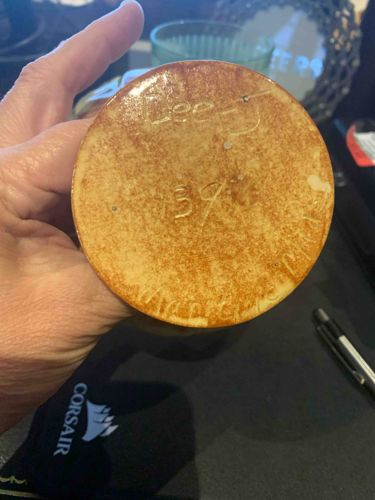
Glazed Ceramic Base with 'Lee 39' Incisions
The item is the glazed base of a ceramic vessel, likely a bowl as suggested by the 'glazed petesdal bowl' context. The underside reveals a rich, mottled golden-brown glaze with darker reddish-brown flecks and areas, typical of an Albany slip or similar reactive glaze often used on utilitarian stoneware. The glaze exhibits a glossy, somewhat uneven finish, indicating a rustic or handcrafted aesthetic. Visible physical characteristics include a circular flat base with a distinct, slightly raised foot rim that is also glazed, which is a common feature in pottery to prevent the main body from touching surfaces and to add stability. The material appears to be a robust earthenware or stoneware clay, given the opaque, earthy color of the glaze. Hand-incised markings are clearly visible on the base. The prominent marking is a name, 'Lee', inscribed in a flowing script, suggesting it might be the artist's or maker's signature. Below this, the numbers '39' are also incised, which could represent a date (e.g., 1939) or an inventory/production number. Another faint, illegible inscription runs along the lower edge of the base, possibly more text or a symbol that is too worn or lightly incised to discern from the image. In terms of condition, there are several small, unglazed pinprick-like spots or 'stilt marks' visible, which are common manufacturing artifacts where the ceramic piece rested on kiln stilts during firing. These are not damage but rather evidence of the firing process. The overall patina suggests age, with some subtle variations in the glaze's smoothness, but no obvious chips, cracks, or significant wear are discernible from the base alone. The craftsmanship appears competent for handmade pottery, with the inscriptions suggesting a personal touch. Based on the visible markings and the style of glazing, it likely dates to the mid-20th century, specifically if '39' denotes the year 1939, aligning with a more artisanal, studio pottery movement period.
AI-Generated Appraisal Disclaimer
Estimated Value
$40-60
Basic Information
Category
Ceramics
Appraised On
December 2, 2025
Estimated Value
$40-60
Additional Details Provided By Owner
User Provided Information
Glazed petesdal bowl
Item Description
The item is the glazed base of a ceramic vessel, likely a bowl as suggested by the 'glazed petesdal bowl' context. The underside reveals a rich, mottled golden-brown glaze with darker reddish-brown flecks and areas, typical of an Albany slip or similar reactive glaze often used on utilitarian stoneware. The glaze exhibits a glossy, somewhat uneven finish, indicating a rustic or handcrafted aesthetic. Visible physical characteristics include a circular flat base with a distinct, slightly raised foot rim that is also glazed, which is a common feature in pottery to prevent the main body from touching surfaces and to add stability. The material appears to be a robust earthenware or stoneware clay, given the opaque, earthy color of the glaze. Hand-incised markings are clearly visible on the base. The prominent marking is a name, 'Lee', inscribed in a flowing script, suggesting it might be the artist's or maker's signature. Below this, the numbers '39' are also incised, which could represent a date (e.g., 1939) or an inventory/production number. Another faint, illegible inscription runs along the lower edge of the base, possibly more text or a symbol that is too worn or lightly incised to discern from the image. In terms of condition, there are several small, unglazed pinprick-like spots or 'stilt marks' visible, which are common manufacturing artifacts where the ceramic piece rested on kiln stilts during firing. These are not damage but rather evidence of the firing process. The overall patina suggests age, with some subtle variations in the glaze's smoothness, but no obvious chips, cracks, or significant wear are discernible from the base alone. The craftsmanship appears competent for handmade pottery, with the inscriptions suggesting a personal touch. Based on the visible markings and the style of glazing, it likely dates to the mid-20th century, specifically if '39' denotes the year 1939, aligning with a more artisanal, studio pottery movement period.
Related Tags
Get Your Items Appraised
Instant estimates of your treasures with AI-powered instant appraisals